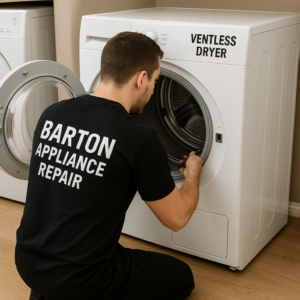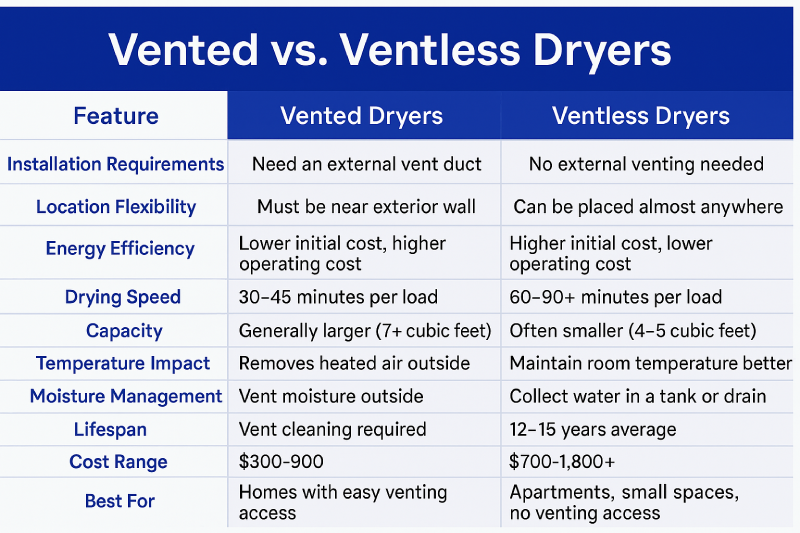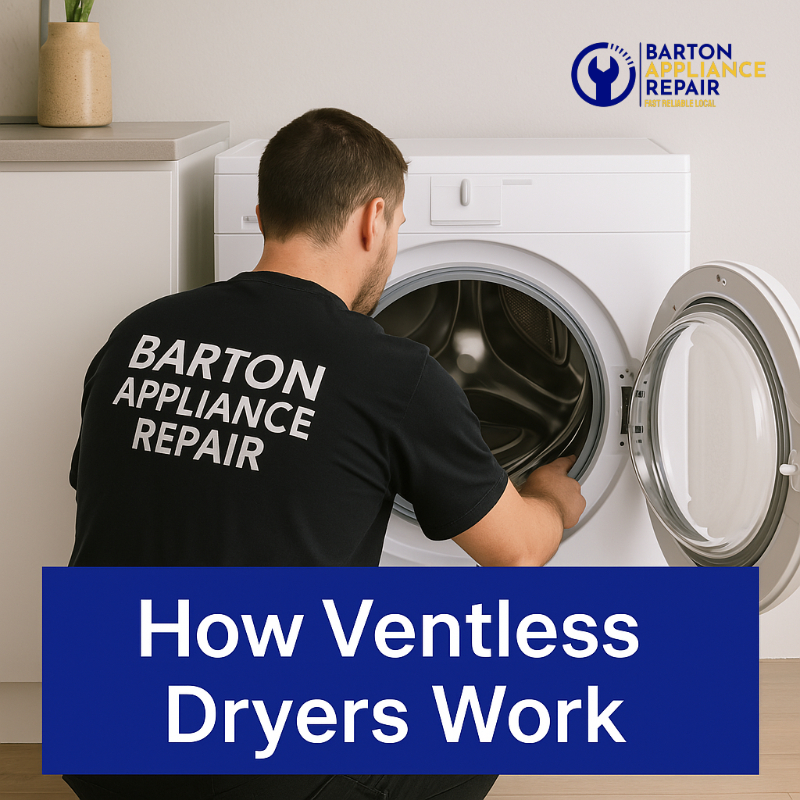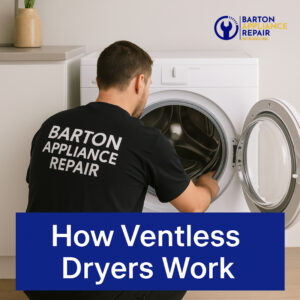New laundry solutions continue to evolve to make doing laundry even more convenient and effortless. Between the innovations, however, ventless dryers have stood out and become popular, particularly for homeowners with limited space or unique installation issues. Learning how these machines work and the possible advantages of using them can assist in determining if a ventless dryer will be suitable for your household.
A Ventless Dryer
This works a little differently from normal vented models. Most old dryers that release hot, moist air through a duct system to the outside of your home, ventless dryers process and handle moisture internally. This difference eliminates the need for an outside venting structure, creating flexibility in placement and installation.
These appliances come in two main varieties: condenser and heat pump dryers. Both types get you the same goal of drying your clothes without external venting. But they use different technologies and mechanisms to finish the task.
Related: What’s the Best Dishwasher You Can Buy in Canada?
How Does a Ventless Dryer Work?

The technology behind this appliance is very fascinating and shows that we have come a long way from older drying methods. Getting to know these mechanics will help you understand better how they work.
Condenser Dryers
They function through a closed-loop air circulation system. This is their process:
- Air Heating: The dryer pulls in the environmental air from the room and heats it using an electrical heating element.
- Moisture Collection: This heated air flows through the tumbling clothes and takes away all the moisture.
- Condensation Process: It doesn’t take out the humid air outside. But, it passes through a heat exchanger or condensing chamber.
- Water Separation: As this air cools in the condensing unit, the moisture turns into water droplets.
- Water Collection: These droplets get collected in a removable reservoir or are pumped directly into a drain.
- Air Recirculation: The now-cooler and drier air returns to the heating element, where the cycle begins again.
This whole process helps condenser dryers to function without external venting while removing moisture from your laundry.
Heat Pump Dryers
These dryers are more advanced and come under the energy-efficient category of ventless dryers. They operate on principles that are similar to refrigeration.
- Initial Air Circulation: Room-temperature air flows through the drum. It collects all the moisture from the wet clothes.
- Heat Exchange – First Phase: The moisture-loaded air goes through an evaporator coil, which cools it down and condenses the water.
- Water Collection: Like condenser models, the condensed water collects in a reservoir or drains away.
- Heat Exchange – Second Phase: The cooled air then passes through a condenser coil. It reheats the air with the heat captured in the first place.
- Energy Recycling: This heat recovery system reuses the thermal energy rather than making new heat.
- Continuous Operation: The warmed air cycles back into the drum, and the process repeats until the clothes are dry.
Heat pump technology creates a much better thermal cycle that takes less electricity while still achieving effective drying performance.
Related: The Top 5 Smart Appliances Every Modern Household Needs
Vented vs. Ventless Dryers: A Comparison

This comparison tells you about the differences between old vented dryers and ventless ones:
Feature |
Vented Dryers |
Ventless Dryers |
| Installation Requirements | Needs an external vent duct | No external venting needed |
| Location Flexibility | Must be near exterior wall | Can be placed almost anywhere |
| Energy Efficiency | Lower initial cost, higher operating cost | Higher initial cost, lower operating cost |
| Drying Speed | 30-45 minutes per load | 60-90+ minutes per load |
| Capacity | Generally larger (7+ cubic feet) | Often smaller (4-5 cubic feet) |
| Temperature Impact | Removes heated air outside | Maintains room temperature better |
| Moisture Management | Vents moisture outside | Collects water in a tank or drain |
| Maintenance | Vent cleaning required | Filter and condenser cleaning required |
| Lifespan | 10-13 years average | 12-15 years average |
| Cost Range | $300-900 | $700-1,800+ |
| Best For | Homes with easy venting access | Apartments, small spaces, no venting access |
Advantages of Ventless Dryers
Ventless dryers have a lot of benefits that make them right for many households:
Installation Flexibility
Without the need for external venting, ventless dryers can be placed virtually anywhere with access to electricity and proper drainage (if not using the water collection tank). This flexibility proves invaluable for:
- Apartment dwellers with limited installation options.
- Historic homes have structural modifications that are restricted.
- Interior rooms with no external wall access.
- Small spaces where old venting would be impractical.
The ability to install these appliances in closets, bathrooms, or kitchen areas opens up possibilities for many living situations.
Energy Efficiency
Heat pump ventless dryers in particular demonstrate impressive energy conservation:
- They consume approximately 20-50% less electricity than normal dryers.
- The heat recovery system repurposes thermal energy rather than continuously generating new heat.
- Their lower operating temperatures protect fabrics while reducing energy consumption.
- Many models carry Energy Star certification, confirming their efficiency.
Over time, these efficiency gains can translate into meaningful utility bill savings despite the higher initial purchase price.
Space-Saving Designs
Ventless technology allows a lot of space-conscious changes:
- Compact dimensions suitable for smaller homes.
- Stackable washer-dryer combinations that use vertical space.
- All-in-one washer-dryer units that perform both functions in a single appliance.
- Under-counter installation options for integrated kitchen or bathroom setups.
For urban living or downsized homes, these space-saving attributes can prove important.
Related: The Top 5 Smart Appliances Every Modern Household Needs
Environmental Considerations
The ecological footprint of ventless dryers can be smaller than old models:
- Less energy consumption = lower carbon emissions.
- Heat pump models avoid releasing heated air outside, improving indoor temperature regulation.
- The closed system prevents the outdoor pollutants from entering the vent structure.
- Longer appliance life because of simpler mechanical systems.
For environmentally conscious people, these factors can make ventless dryers an attractive option.
Limitations to Consider
While ventless dryers offer a lot of advantages, they also come with certain limitations that potential buyers should think about:
Extended Drying Times
Ventless dryers usually take longer to complete a drying cycle:
- Condenser models may require 30-45 minutes more per load.
- Heat pump dryers work at lower temperatures, so the drying process is longer.
- Larger loads might need to be divided for effective drying.
- Some fabric types might need additional time to reach desired dryness.
These longer cycle times need you to plan ahead for laundry tasks.
Ambient Room Conditions
The operating environment affects ventless dryer performance:
- Ideal operation needs room temperatures between 50-95°F (10-35 °C).
- Performance may decline in extremely hot or cold conditions.
- Adequate room ventilation helps manage the small amount of heat released.
- Higher room humidity can extend drying times as the unit works harder to process moisture.
Installing ventless dryers in a properly ventilated space optimizes their performance.
Initial Cost Investment
Ventless technology usually has a premium price:
- Heat pump models can cost 30-100% more than standard vented dryers.
- Condenser models fall in the middle price range.
- Advanced features and higher efficiency ratings increase the costs.
- Installation might need specific electrical connections or drainage solutions.
However, long-term energy savings can help offset this higher initial investment.
Capacity Constraints
Many ventless models offer somewhat smaller drum capacities:
- Compact models usually handle 4-5 cubic feet of laundry.
- Full-size ventless units still often run smaller than maximum-capacity vented models.
- Larger households might need to frequently wash clothes.
- Bulky items like comforters would need commercial laundering.
Houses that have a lot of laundry should think about these capacity limitations.
Maintenance Requirements
Proper maintenance makes sure of the best performance and longevity for ventless dryers:
Filter Cleaning
All ventless dryers include multiple filtration systems that need regular attention:
- Lint filters need cleaning after every load to maintain airflow.
- Condenser coils need monthly cleaning to prevent buildup.
- Secondary filters may need periodic washing to remove finer particles.
- Heat exchangers benefit from occasional gentle cleaning.
- Neglecting these maintenance tasks can reduce efficiency and performance.
Water Management
For models with water collection systems:
- Condensation tanks usually need emptying every 1-3 loads.
- Direct drain connections require checking for clogs or kinks.
- Water sensors should be tested to avoid overflow.
- Drain pump filters need occasional cleaning to remove debris.
These water management tasks are simple but necessary for proper operation.
Ventilation Considerations
Even though they don’t need venting, these dryers still need proper air circulation:
- Make sure of adequate clearance around the unit as specified by the manufacturer.
- Room temperature affects performance, so avoid extremely cold locations.
- Periodic room airing helps manage any minimal heat outlet.
- Consider humidity levels in the installation space.
Creating better operating conditions extends the life and enhances the performance of ventless dryers.
Related: How Much Does It Cost to Fix a Washing Machine?
How to Choose a Ventless Dryer?
Determine Your Space Requirements
- Measure available space dimensions precisely.
- Consider the clearance needed for door opening and control assessment.
- Determine whether a compact or full-size model fits your space.
- Evaluate stacking options if vertical space exceeds horizontal space.
- Check for proper electrical outlet availability.
Assess Your Laundry Habits
- Calculate your typical load volume per week.
- Consider the types of fabrics you commonly dry.
- Check if longer drying times fit your schedule.
- Determine if you need specialized cycles for delicates or bulky items.
- Consider whether you typically dry full or partial loads.
Evaluate Ventless Technologies
- Heat pump models offer the highest efficiency but the longest drying times.
- Condenser models balance moderate efficiency with somewhat faster drying.
- All-in-one washer-dryer combinations save space but have a smaller capacity.
- Compact models work well for individuals or couples.
- Standard-size models fit a family’s needs better.
Budget Considerations
- Factor in both purchase price and long-term operating costs.
- Calculate potential energy savings over the expected lifespan.
- Research available rebates or incentives for energy-efficient models.
- Consider installation costs for electrical work if needed.
- Weigh warranty coverage and expected maintenance costs.
Feature Priorities
- Moisture sensors prevent over-drying and save energy.
- Multiple heat settings fit different fabric types.
- Express cycles help when time is limited.
- Wi-Fi connectivity enables remote monitoring and control.
- Vibration reduction technology matters in apartments or upstairs installations.
Conclusion
Ventless dryers are the best solutions for modern laundry challenges, especially for those who have lesser space, installation limitations, or energy efficiency concerns. By understanding how they work, customers can make informed decisions about including them into their homes.
Although there are factors like longer drying times, ambient room conditions, and maintenance requirements, a lot of users find that installation flexibility and energy savings overweigh these limitations. For apartment dwellers, or those with structure restrictions, ventless dryers can change the laundry capabilities without needing home modifications.
So, before making any appliance purchase, evaluate your needs, space, and budget. With proper maintenance and reasonable expectations about performance, these appliances can be super convenient laundry solutions for years to come.
Related: Complete List of LG Dishwasher Error Codes and Quick Fixes





